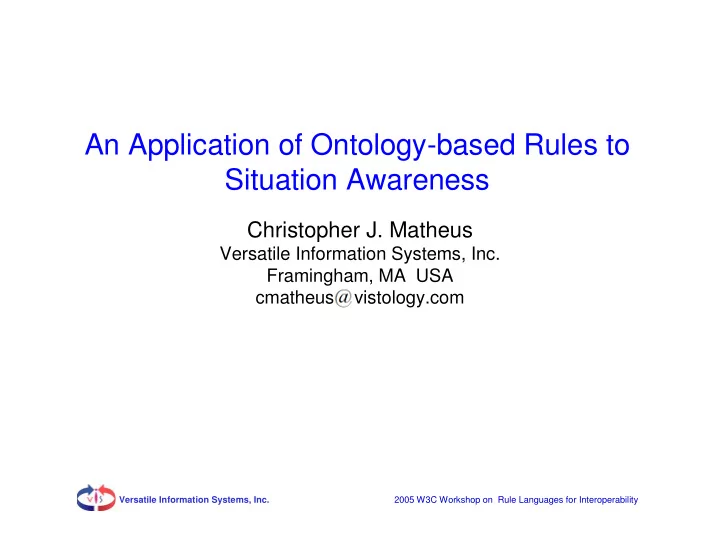

An Application of Ontology-based Rules to Situation Awareness Christopher J. Matheus Versatile Information Systems, Inc. Framingham, MA USA cmatheus vistology.com Versatile Information Systems, Inc. 2005 W3C Workshop on Rule Languages for Interoperability
Outline • Problem Domain: Situation Awareness • High-level Methodology • Specific Use Cases • Issues/Challenges with SWRL ---------------- • Rule Language Requirements Wish List Versatile Information Systems, Inc. 2005 W3C Workshop on Rule Languages for Interoperability
Our Problem Domain • R&D focus: Formal yet Practical Applications for Situation Awareness & Information Fusion • Situation Awareness (SAW): – an understanding of what’s going on in an evolving situation e.g. battlefield, financial markets, crisis management – involves fusion of object-level data from multiple sources into meaningful higher-order relations – highly context dependent and goal directed • Requirements for effective SAW apps: – domain knowledge about relevant objects and their properties – specification of conditions that define higher-order relations – a means for reasoning about time-dependent sensor information in the context of the given domain knowledge – much in common with SW goals of knowledge representation and processing but with real-time and uncertainty concerns Versatile Information Systems, Inc. 2005 W3C Workshop on Rule Languages for Interoperability
VIS Use Cases • SAWA: Situation Awareness Assistant (AFRL) – Components: • Knowledge Management: ezOwl & RuleVISor • Runtime: Jess/BaseVISor inference/query engine – Domain: supply logistics • SIXA: Semantic Information eXchange Arch. (ONR) – ontology-based (C2IEDM/OWL) information mediation – reason about track data using pedigree ont & rules • Situation Development Adviser (Army) – battlefield ontology – doctrinal and heuristic rules of ECOA (SWRL?) Versatile Information Systems, Inc. 2005 W3C Workshop on Rule Languages for Interoperability
RuleVISor Versatile Information Systems, Inc. 2005 W3C Workshop on Rule Languages for Interoperability
High-Level Methodology Working with Subject Matter Experts we: • develop OWL ontologies for describing domain- specific object classes and object properties • develop SWRL* rules to define relations that are grounded in observable data annotated by ontologies • convert rules to Jess or BaseVISor rules using XSLT • establish an input stream of events describing object observations annotated using the domain ontologies – all observed values annotated with units, time, certainty, and source derived from an Event ontology • use Jess/BaseVISor engine to process event stream and detect evolution of higher-order relations Versatile Information Systems, Inc. 2005 W3C Workshop on Rule Languages for Interoperability
Issues/Challenges with SWRL • Restriction to binary predicates makes many rules very difficult to construct and understand – e.g. criticalPartAtFacility(?Part,?Fac,?Time,?Amt) – e.g 9 rules turned into >1000 lines of SWRL code • Declarative Semantics vs Implementation – SWRL built-ins • need functional built-ins that specify input and output terms • e.g., swrlb:sum(100,?X, ?Y) with unbound vars is infinite • practical solution: detect the one unbound var to determine the function to compute (multiple unbound vars throws error) – No explicit generation/assertion of new facts • issue with vars in head that are unbound in the body • need assert() and gensym() Versatile Information Systems, Inc. 2005 W3C Workshop on Rule Languages for Interoperability
criticalPartAtFacility(?Part,?Fac,?Tine,?Amt) <swrlx:classAtom> <owlx:Class owlx:name="#CriticalPartAtFacility"/> <ruleml:var>?CPFStatement</ruleml:var> </swrlx:classAtom> <swrlx:individualPropertyAtom swrlx:property="#criticalPart"> <ruleml:var>?CPFStatement</ruleml:var> <ruleml:var>?Part</ruleml:var> </swrlx:individualPropertyAtom> <swrlx:individualPropertyAtom swrlx:property="#criticalFacility"> <ruleml:var>?CPFStatement</ruleml:var> <ruleml:var>?Facility</ruleml:var> </swrlx:individualPropertyAtom> <swrlx:datavaluedPropertyAtom swrlx:property="#criticalTime"> <ruleml:var>?CPFStatement</ruleml:var> <ruleml:var>?Time</ruleml:var> </swrlx:datavaluedPropertyAtom> <swrlx:datavaluedPropertyAtom swrlx:property="#criticalDeficit"> <ruleml:var>?CPFStatement</ruleml:var> <ruleml:var>?SurplusOrDeficitAmount</ruleml:var> </swrlx:datavaluedPropertyAtom> Versatile Information Systems, Inc. 2005 W3C Workshop on Rule Languages for Interoperability
Issues/Challenges (continued) • Time issues – usually need to make decisions from partial information • requires NAF (could be within scoped context ala N3) – need to model time-dependent attributes (e.g. position) • more appropriately done as a procedural attachment – some computed information is needed only occasional – time stamping • all data needs to be time stamped • asserted inference results also need to be time stamped • rules need to be time aware Versatile Information Systems, Inc. 2005 W3C Workshop on Rule Languages for Interoperability
Top Ten Rule Wish List 1. Rules definable on top of OWL ontologies 2. NAF, perhaps within a scoped context (ala N3) 3. Procedural attachments 4. Explicit representation of non-binary predicates 5. Explicit generation of new facts (assert,gensym) 6. Functionally defined built-ins 7. Graphical means to generate/understand rules 8. Means of generating simple explanations of conclusions 9. Real-time or near-real-time performance 10. Built-in support for reasoning about uncertainty Versatile Information Systems, Inc. 2005 W3C Workshop on Rule Languages for Interoperability
Recommend
More recommend